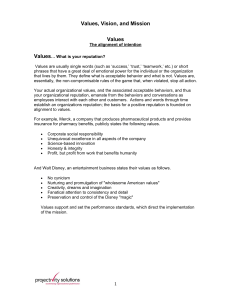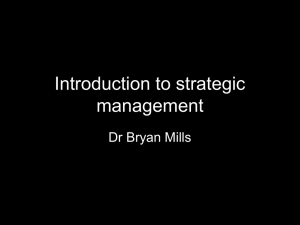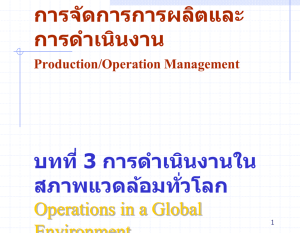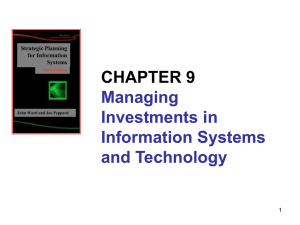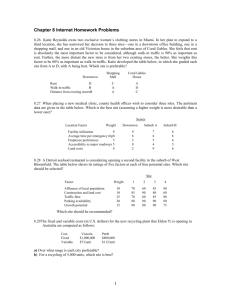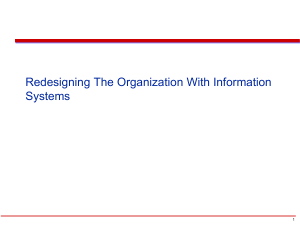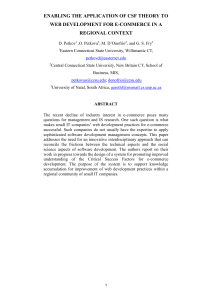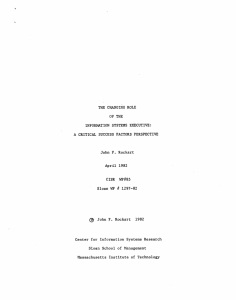Tools for the information strategy planner: critical success factors
advertisement
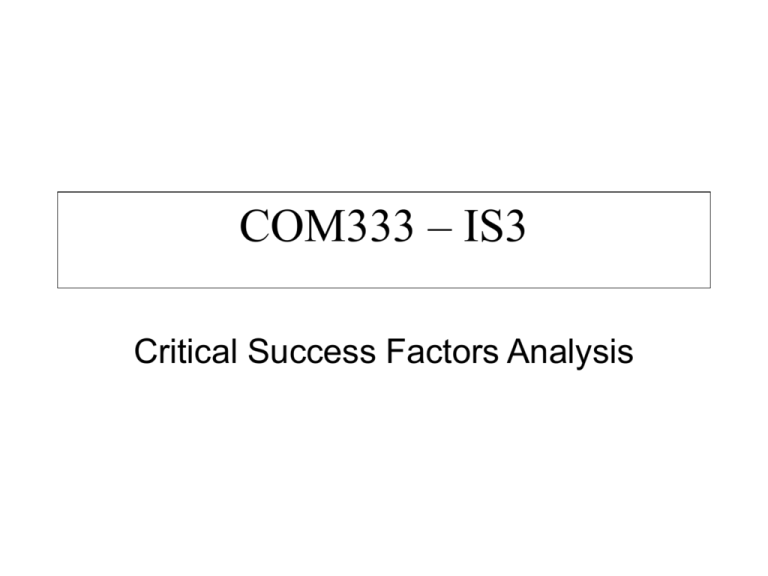
COM333 – IS3 Critical Success Factors Analysis • Information requirement analysis – Identifying the information that is needed in order to operate and mange the organisation so that the organisation can identify what IS should deliver. What IS need to developed – IS strategy 2 • Determining the IS Demand – One way is to ask each area of the business their requirements. • Provide a wish list, • No genuine priorities associated with the list • No knowledge of the inherent demand in the business strategy. 3 • Another way is a group charged with defining or updating the IS/IT strategy to – Absorb every written strategy statement – Interpret them into relevant IS/IT principles and CSFs, application requirements associated with major planned initiatives, and a set of supply criteria to deliver the service demanded by the business. • Issues – Strategy is not well documented all the time – Inability to feed into the development of strategy 4 • The best option is to develop the IS demand parallel with the business strategy. – Feeding trends, ideas opportunities into the top level business strategy – Working closely with the areas of business in building up a set of achievable business and associated IS/IT initiatives that will deliver the targeted performance. 5 • Need to obtain a profound understanding of the drivers for change, derived from – Needs and objectives – The current situation (where we are) – Articulate the situation being sought (where we want to be) – Start to propose how the gaps might be closed (how to get there). • These are achieved through a mixture of fact finding and analysis focused on the elements of the business and technical environments. 6 SWOT CSFs Value Chain Business Model Business Strategy Current and Expected Business and Technical Environments Current Status of IS/T IS//IT Opportunities Proposed business initiatives Determine the IS Demand Impact from IS//IT Potential Status of IS/T Proposed IS/IT initiatives Determine the IS demand 7 • Analysis of business strategy • Analysis of current and expected future business environment • • Analysis of internal business environment Identification of Critical Success Factors of the business • • • • • • Identification and analysis of the internal and external value chain • Further value chain analysis • • Evaluation of the current application portfolio • Identify the components and associated information needs Determine how IS/IT can contribute to strengthening the business’s competitive positioning Understand the relevant organisational characteristics, SWOTs and other factors Crystallise the essential characteristics of success in meeting the objectives stated in strategy Identify the most important information flow through the business and across its value chain partners Bring into focus the potential opportunities for improving the value delivered by the information Determine the inventory of the ISs in use, in development and assess their contribution and potential. 8 • Critical Success Factors (CSFs) – “things must go right” (Rockart, 1979) for the business to flourish – “are those handful of things that within someone’s job must go right for the organisation to flourish. They are the factors that the manager wishes to keep a constant eye upon.” (Robson) – “An internal or external business-related result that is measurable and that will have a major influence on whether a business segment meets its goals.” (Martin) – “The limited number of areas in which results, if they are satisfactory, will ensure successful competitive performance for the organisation ... If the results in these areas are not adequate, the organisation’s efforts for the period will be less than desired.” (Rockart) 9 • CSF analysis is a popular and powerful in IS/IT strategy planning and business planning. • It can be used in number of different ways and for different purposes. – Most effective technique in • involving the senior management in IS planning, because it is wholly rooted in business issues • and in gaining their commitment to proposed IS actions that contribute achievement in critical areas – Enables linking of candidate IS projects through CSFs to objectives – In individual interviews with senior management , it is a good catalyst in unearthing their own individual information needs – By providing a link between objectives and information requirements, the CSF can play an important role in prioritising candidate schemes – It is particularly useful in IS planning when the business strategy has not been progressed beyond objectives by focussing attention on the most critical aspects of the business that need action taken to improve their performance. – It is extremely powerful when used alongside value chain analysis in identifying the most critical processes, and enabling ownership of the CSF and is associated actions to be accurately pinpointed. 10 • CSF analysis is used for the purpose of interpreting the business objectives, tactics and operational activities in terms of key information needs of the organisation and its managers, and strengths and weaknesses of the existing systems. 11 Corporative Objectives Corporative CSFs Business Unit Objectives Business Unit CSFs 12 • CSFs differ from industry to industry, between organisations within the same industry, and from one time period to another in the same organisation. • So there are five influential factors to consider – the industry or sector – all the organisation within one industry will share this – the competitive strategy or industry position – large players may determine these for the smaller players – environmental factors – the economy, country or politics etc – temporal factors – those are not ‘normally’ of concern but are so ‘for a time’ – managerial position – CSF will vary with the level in the hierarchy. • The higher up the management triangle more likely it is that CSF will be of the building variety – tracking the progress of changes. • Lower level of management have CSFs relating to monitoring of current operations. 13 Industry CSFs Organisational CSFs Business Unit or Function CSFs Manager’s CSFs CSFs Levels 14 Understand the mission and objectives Determine the CSFs for each objective Conduct a SWOT on each CSF Develop measures Result: guide for the executive information system Consolidate across objectives and identify information dependencies Result: outline plan of IS requirements 15 • CSFs are needs, • They help to bridge the gap between those who can act upon information and those who can provide it. • they do not specify information systems or applications. • They identify information requirements which may be the basis of an information system. 16 Identify CSF CSF KD IR IR KD IR KD Identify key decisions related to the CSFs KDs provide bridge to the information requirements 17 • Example – One of the objectives of an oil company is “to achieve 1% growth in market share” Tactics CSFs Improve the performance across all regions at rates in excess of the industry average. Competitive pricing To improve performance in those regions which are currently under performing to match national average Level of advertising, national and local Remuneration of site managers Distribution of sites Measures Company prices versus average price Amount paid versus industry average Proportion of top turnover sites Site density / market size ratio Amount spent versus industry average 18 • CSFs were identified with reference to the objective and its supporting tactics. • Having determined appropriate measures, the organisation identified more activities that it needed to do to meet its CSFs – – – – Survey prices Review and survey salaries Review demographics of site locations Compare advertising expenditure against the industry average • These in turn each have information requirements and associated performance measurement activities. 19 1 Business objectives • Raise shares earnings • Increase market share • Develop new business • Develop internationally 2 Critical success Factors Create new market Find new product Automate factories Develop world wide image Improve product quality 3 information system needs Develop customer intelligence Install new product database Investigate FMS Develop profit analysis and financial control Explore CAD link with customers 1. Strategy group identify and agree on the objective of the SBU 2. Management team interview managers, get opinions and resolve conflicts to agree. Reveal critical process and activities 3. Apply technology to products and process. Develop IS management support and co-ordinate and control 20 critical activities. • General guidelines on CSF – CSFs are very flexible which can entice some organisations to be too casual about their use. • Casual applications can provide false results. • CSFs should used within the same precision on as formal methods – The person managing the CSF study should have a thorough understanding of the organisation’s business. – It is helpful to have a senior management champion – Educate the staff members involved in the CSF method before the actual interview – Do not link concrete information such as information needs, computer applications etc during the first round of interviews. – Try to use several management levels in order to validate the CSFs and to get a broader picture and higher organisational CSFs. 21 • There are lots of derivatives of CSF analysis • All follow the top down approach • Henderson’s work on critical sets is a variant of CSF analysis. – This model suggest a three stage process can identify the IS strategy. 22 • Understand the business using – Five forces model – Value chains • Identifying information needs using – Critical sets – High level data model • Ranking IS/IT opportunities – Placing onto a two by two matrix segment • Ranking is done by – Analysing the critical/key assumptions by their degree of stability and their importance to the business strategy – Then analysing the critical/key decisions by their importance to the business strategy and the scope there is for the IS/IT to enhance their decision making process 23 Business Strategy Feedback Goals of Management Critical Success Factors CAS (Assumptions) CIS (Information) CDS (Decisions) Monitor Input Support EIS Analysis MIS Analysis DSS Analysis 24 CSF extended: critical information set High Low investment justifiable High investment justifiable Little or no investment justifiable Low investment justifiable Stability Low Low High Importance Critical assumptions ranked by analysing them by their degree of stability and their 25 importance to the business strategy High Low development cost justifiable High development cost justifiable Little or no justifiable cost Low development cost and/or higher operating cost justifiable Scope for enhancement Low Low High Importance Critical decisions ranked by their importance to the business strategy and the scope 26 there is for the IS/IT to enhance their decision making process • Limitations – To be of value, the CSF should be easily and directly related back to the objectives of the business unit under review. From experience people found generally it loses its value when used below third level in an organisation hierarchy. – CSFs tend to be internally focused and analytical rather than creative – CSFs, partly, reflect a particular executives management style. – Needs very skilled and very perspective interviewers to do the abstracting of CSFs from senior managers – Mangers who are not really involved with strategic planning find it difficult to apply CSF analysis – It is usually impossible to build a true picture of the organisations information requirements using only CSFs. – Resultant decisions may ignore any resources constraints surrounding their management 27

